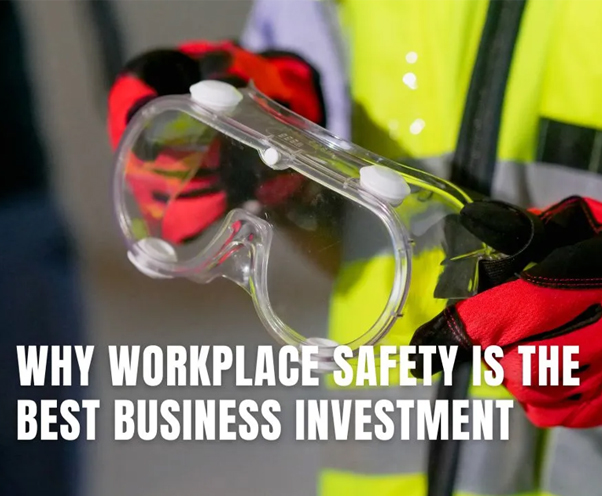The Business Value of Investing in Safety Innovation

Investing in safety innovation is often seen as a moral and legal obligation, but its role as a strategic business advantage is sometimes overlooked. However, forward-thinking companies understand that enhancing workplace safety is not just about compliance; it’s also a smart investment that can drive business success. Safety innovation, which involves adopting new technologies, processes, and practices to improve occupational safety and health (OSH), can lead to significant benefits, including reduced costs, improved productivity, enhanced reputation, and increased employee engagement. This article explores the business case for safety innovation, highlighting why it should be a priority for every organization.
The Financial Impact of Workplace Safety
Workplace accidents and injuries can be costly. The direct costs include medical expenses, workers’ compensation claims, and legal fees, while the indirect costs can be even more significant. These may include lost productivity, training costs for replacement workers, equipment repairs, and increased insurance premiums. Additionally, accidents can lead to downtime, which disrupts operations and impacts revenue.
For example, according to the National Safety Council, the average cost of a workplace injury in the United States is around $42,000. For a serious injury, the costs can escalate into hundreds of thousands of dollars, depending on the severity and the industry. Beyond these quantifiable costs, there are less tangible impacts such as damage to the company’s reputation, loss of customer trust, and diminished employee morale.
By investing in safety innovation, companies can mitigate these risks. Reducing the incidence of workplace accidents and injuries not only saves money but also improves operational efficiency and enhances overall business performance.
Enhancing Productivity and Efficiency
Safety and productivity are often seen as competing priorities, but they are closely linked. A safe work environment minimizes disruptions caused by accidents, ensuring that operations run smoothly. When workers feel safe, they are more likely to be engaged and focused on their tasks, leading to higher productivity.
Safety innovations, such as automation, wearables, and data analytics, can streamline processes and reduce the time spent on hazardous tasks. For instance, automating repetitive or dangerous tasks can eliminate the risk of injury and allow workers to focus on more value-added activities. Similarly, wearable technology can monitor workers’ health and environmental conditions in real-time, enabling timely interventions that prevent accidents and keep production on track.
Moreover, by implementing predictive analytics, companies can anticipate potential hazards and address them before they cause disruptions. This proactive approach not only enhances safety but also ensures that operations are more resilient and less prone to unexpected interruptions.
Building a Stronger Brand and Reputation
In today’s market, consumers and investors are increasingly aware of corporate social responsibility (CSR) and are more likely to support companies that prioritize safety and ethical practices. A strong safety record can enhance a company’s brand and reputation, making it more attractive to customers, partners, and investors.
Safety innovation demonstrates a commitment to protecting workers and the environment, which can differentiate a company from its competitors. For instance, companies that invest in green technologies or sustainable practices not only reduce environmental risks but also appeal to environmentally conscious consumers. Similarly, businesses that prioritize employee well-being through safety innovations are more likely to attract top talent and retain skilled workers.
A positive reputation for safety can also open doors to new business opportunities. Companies with strong safety credentials may be preferred partners in industries where safety is a critical consideration, such as construction, manufacturing, and energy. Furthermore, a solid safety record can be a deciding factor in winning contracts, particularly in highly regulated sectors.
Reducing Regulatory and Legal Risks
Compliance with safety regulations is a fundamental requirement for any business. Failure to comply can result in hefty fines, legal actions, and even the shutdown of operations. Regulatory bodies, such as the Occupational Safety and Health Administration (OSHA) in the United States, have stringent requirements that companies must meet to ensure the safety of their employees.
By adopting safety innovations, companies can stay ahead of regulatory changes and avoid the risks associated with non-compliance. Advanced safety technologies, such as real-time monitoring systems, can help organizations maintain compliance by providing accurate data and documentation of safety practices. This not only reduces the risk of penalties but also ensures that companies are better prepared for inspections and audits.
In addition, safety innovations can mitigate the risk of legal action from employees or third parties. For example, implementing AI-driven systems to monitor workplace safety can provide evidence that the company has taken reasonable steps to protect its workers, which can be crucial in defending against liability claims.
Fostering a Culture of Safety and Engagement
A culture of safety is essential for the success of any safety program. When safety is embedded in the organizational culture, employees are more likely to adhere to safety protocols and actively participate in safety initiatives. This leads to a safer work environment and reduces the likelihood of accidents and injuries.
Investing in safety innovation sends a clear message that the company values the well-being of its employees. This can boost morale and foster a sense of loyalty and commitment among workers. When employees feel that their employer cares about their safety, they are more likely to be engaged and motivated to contribute to the company’s success.
Furthermore, involving employees in the development and implementation of safety innovations can enhance their buy-in and ownership of safety practices. This participatory approach can lead to more effective safety solutions that are tailored to the specific needs and challenges of the workforce.
Leveraging Technology for Competitive Advantage
Technological advancements are transforming the landscape of workplace safety. Innovations such as the Internet of Things (IoT), artificial intelligence (AI), and big data analytics offer new ways to enhance safety and gain a competitive edge.
For example, IoT devices can collect and analyze vast amounts of data on workplace conditions, providing insights that can be used to predict and prevent accidents. AI can be used to identify patterns and trends in safety data, enabling companies to take proactive measures to mitigate risks. Similarly, virtual reality (VR) and augmented reality (AR) can be used for immersive safety training, allowing workers to practice handling hazardous situations in a controlled environment.
By embracing these technologies, companies can not only improve safety but also optimize their operations and gain a competitive advantage. For instance, predictive maintenance systems can reduce downtime and extend the life of equipment, leading to cost savings and improved productivity.
Measuring the ROI of Safety Innovation
One of the challenges of making the business case for safety innovation is quantifying the return on investment (ROI). While some benefits, such as reduced injury rates and lower insurance costs, are easily measurable, others, such as improved employee morale and enhanced reputation, are more difficult to quantify.
To measure the ROI of safety innovation, companies should track key performance indicators (KPIs) that align with their business goals. These may include metrics such as the reduction in workplace incidents, cost savings from decreased workers’ compensation claims, improvements in productivity, and employee engagement scores. By linking safety initiatives to these KPIs, organizations can demonstrate the tangible value of their investment in safety innovation.
In addition, companies should consider the long-term benefits of safety innovation. While the upfront costs of implementing new technologies or processes may be high, the savings and benefits over time can far outweigh the initial investment. A safer workplace also contributes to long-term business sustainability, as it reduces the risk of catastrophic events that could threaten the company’s viability.
Conclusion
Making the business case for safety innovation requires a shift in mindset from viewing safety as a cost to seeing it as an investment in the future of the company. By adopting innovative safety practices and technologies, organizations can not only protect their workers but also drive business success through reduced costs, increased productivity, enhanced reputation, and stronger employee engagement.
In a competitive marketplace, companies that prioritize safety innovation are better positioned to succeed. They can attract top talent, win new business, and maintain a strong reputation for corporate responsibility. Ultimately, investing in safety innovation is not just about compliance; it’s about building a resilient, sustainable, and profitable business for the future.





.png)







